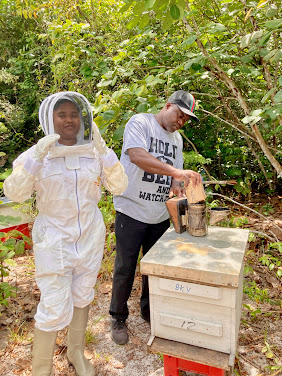International Volunteer Day 2017 | Assignment Highlight
On this International Volunteer Day, Partners' F2F program
would like to highlight a previous team assignment in Guatemala. We would also
like to express our sincerest gratitude and appreciation for all of our F2F volunteers,
past and present, who have exemplified the true meaning of volunteerism.
 |
| Dr. Lindsey du Toit assessing onion crops at a field |
Earlier this year, Lindsey du Toit, Professor of Plant Pathology
at the Washington State University, and Bill Buhrig, Extension Educator at the
Oregon State University, traveled to the Sacapulas region of Quiche in
Guatemala to provide training and assistance to the Association Sacapulteca
(ASPROCE), a collective of onion growers in the region. Combining their
respective expertise in plant pathology, and crop fertility and post-harvest
management, Lindsey and Bill were able to develop a comprehensive analysis of
current onion production practices and recommend ways in which the producers
could improve the quality and quantity of their onion yields.
Dr. du Toit’s assignment focused on helping the growers manage
the diseases that were harming their onion crops and significantly reducing
their yields. Meanwhile, Bill’s assignment had the dual purpose of training
producers in onion crop fertility and post-harvest storage of onions bulbs to
increase the quality and shelf-life of their crops. During the beginning of their
trip, they visited several fields to observe current production practices, pre-
and post-harvest, and evaluate the conditions of the onion crops.
 |
| Bill Buhrig & ASPROCE member at a training session |
Bill observed the post-harvest handling of the crops and storage
facilities being used. While he was impressed with the storage facilities
growers were using, they were also storing many onion bulbs that were infected with diseases like bulb rot and trying
to mitigate infections post-harvest. Following these observations, Bill and
Dr. du Toit worked together to determine the causes of the diseases, like bulb
rot, and the best practices to reduce the risk of infection.
Dr. du Toit specifically assessed the incidences of diseases
that were most prevalent. She observed that the crops grown at higher
elevations experienced a prevalence of bacterial leaf blight, while crops grown
at lower elevations tended to be affected by Iris yellow spot virus (IYSV). She also determined the prevalence
of pink root in crops grown at all elevations.
Both Dr. du Toit and Bill concluded that the key factors triggering
these diseases were excessive irrigation cycles and amounts of fertilizer being
applied to the crops. These practices were contributing to the pre-harvest and
post-harvest bulb rot that the groups were encountering. Bill conducted several
demonstrations using a soil moisture sensor and fertilizer spreader in order to
introduce better ways to measure the amount of irrigation and fertilizer needed.
In addition, the team observed that several onion bulbs were being transplanted
too deep into the ground, which prevented the necks of the bulbs from drying
properly, creating a higher risk for disease infection. They recommended placing
the crops so that approximately 80 percent of each bulb was above the soil.
Through the volunteer team’s assessments and
recommendations, it is expected that ASPROCE growers will be able to take critical
steps towards improving their disease management practices and consequently increase the
quality and quantity of their crops, while also extending storage life.


.png)

Nice post! Máy làm đất loại nào tốt, Cách sử dụng máy xới đất
ReplyDeleteThis is very informative, Thanks for the sharing.
ReplyDeleteWHere to buy allergan-botox-online online
Buy azzalure online
Benefits Of buy neurobloc 1x5000iu online
Increase your butts,hips and boobs with the best quality hydrogel here online
Buy macrolane buttock injection 1500cc online
Buy 4-cprc crystal online
dysport-2x500iu-for-sale-online
Buy pmma buttock injection 2000CC – ARTEFILL online